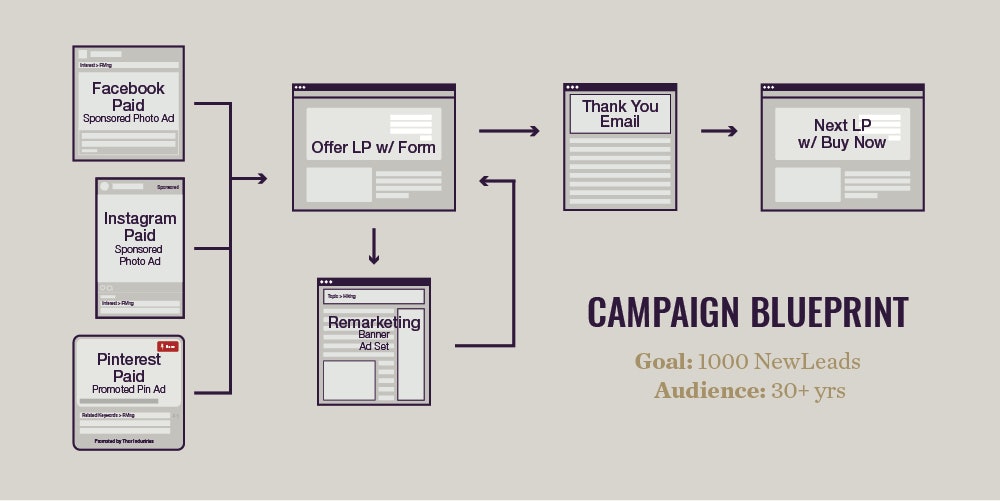If you’ve ever built a seasonal marketing campaign in Salesforce, Mailchimp, or Facebook on the fly, you’ll understand just how easy it is to “do marketing” without anything approximating a documented strategy to guide your efforts. While ad hoc marketing might have worked a few years ago, it doesn’t anymore. For brands and manufactures in the outdoor industry (and candidly, all industries), the multichannel marketing of today is far too complicated to be effectively executed without a detailed, visual strategy to help guide it. Sure, you can do it, but you’re only creating future obstacles for yourself and opening up your brand to unnecessary risk (as I’ll show in a moment).
The solution: a marketing campaign blueprint. A campaign blueprint is a document that helps to identify the purpose of each part of a marketing campaign by graphically laying out all of the campaign’s elements—everything from paid social ads to landing pages to individual email sends. It should include the overall strategic goals of the campaign, the purpose of each element within, and how each tactical element will help reach your goals.
Campaign Blueprints: The Key to Multichannel Marketing Success
(if you’re ready to start building your own campaign blueprint, read this or watch this)
Campaign blueprints are effective tools for marketers across industries, but for brands and manufacturers in the outdoor industry in particular, there are four primary objectives campaign blueprints help to achieve:
- Stakeholder Alignment
- Unifying the Customer Experience
- Translating Stories into Conversions
- Facilitating Repetition
Objective 1: Getting Everyone (Marketing, Sales, Finance, Partners, Retailers, Ambassadors) on the Same Page
For most organizations, campaign blueprints help ensure internal stakeholders are all aligned around marketing’s vision for campaign success. Not only do all the members of the marketing team need to be able to understand the components of a marketing campaign, but generally so should sales, finance, leadership, production…you get the idea. Just being able to get everyone in your organization on board with where your campaigns are heading and the objectives you’re trying to achieve through them is no easy feat.
But for outdoor brands, your task is complicated even further by the stakeholders outside of your organization who also need to be looped in. If you’re not able to clearly demonstrate to your co-branding collaborators, agency partners, brand ambassadors, and especially the retailers carrying your products what the overarching strategy is that’s driving the campaigns you’re running, there will inevitably be details that get lost in the shuffle. Details that will impact not only the results you achieve through your marketing campaigns, but the overall relationship between your brand and your external partners.
The quickest way to make certain a new retailer will love you: show them the blueprint for exactly how you’re going to help them by driving demand for the products they’re going to be carrying in your stores.
Objective 2: Creating a Consistent Experience for Your Customers
This one is massive. Without a referenceable guide that maps out every tactic, channel, and asset you intend to utilize, not only do you have to work harder to keep track of all of the resources at your disposal, you also run the risk of creating a fragmented experience for your customers.
As much as most of us hate to admit it, we generally want companies to know that we’re the same person on our laptop as we are while browsing through Instagram on our iPhones. And we especially want to be able to access the same products, promotions, and events across platforms. While it’s important to create experiences that are appropriate for each platform (e.g., your YouTube strategy is inevitably going to differ from your Pinterest strategy), it will be a jarring experience for your audience if there is no common thread across channels.
Through the intentionality that’s created by the campaign blueprint, you ensure your customer experience is consistent across channels (and you’ll likely increase the number of conversions and purchases in the process).
Objective 3: Translating Lifestyle Content into Conversions
It’s safe to say the outdoor industry outperforms other consumer-focused verticals in its ability to tell compelling narratives. Fortunately, the industry has a lot to draw from: from the individuals, athletes, and families who are shaped by our products, to the incredible locations in which they’re used, to the founders who started the organizations in the first place, outdoor industry marketing is about highlighting compelling stories, not creating them.
But if we can’t bridge the gap between the stories we’re telling and meaningful action, then our job isn’t done. Whether you’re trying to promote a cause or encourage a sale, you have to be intentional about how you’re using lifestyle content and product stories to facilitate the journey of your customers and fans. The campaign blueprint helps you to achieve this—everything you share, send, post, publish, distribute, or host has an end objective in mind, ensuring no efforts are launched in a silo without a clear strategy to drive them.
Objective 4: Making Things Easier for Future You to Duplicate
Lastly, it’s important to note that not every campaign you launch is going to be built from scratch. There’s a lot to be learned from previous efforts, and there’s no harm in recycling, refurbishing, or building upon campaigns that have been successful for you in the past. When you use campaign blueprints to drive your marketing efforts, it makes repeating and improving those efforts significantly easier. Given the seasonality of the outdoor industry, your ability to get your offers and your message out efficiently can often be a differentiator between market leaders and market laggards.
How to Build a Campaign Blueprint
If you’re convinced that it’s worth your team’s time to more effectively document the strategy behind the campaigns you’re running with a blueprint, your next step is to build the dang thing. It’s easier said than done, for sure, but fortunately, there are plenty of models out there for what should go into a campaign blueprint and which tools you can use to build them.
For your convenience, we’ve published both a blog post and a webinar dedicated to walking you through the blueprint-building process step-by-step; use them if you find the information helpful!
What’s most important is that you start integrating blueprinting into your marketing operations sooner rather than later. The longer you go without documenting your campaign strategy, the more you risk wasting time, burning cash, losing conversions, and frustrating your team, partners, and customers. And frankly, none of those are outcomes any of us can afford.






